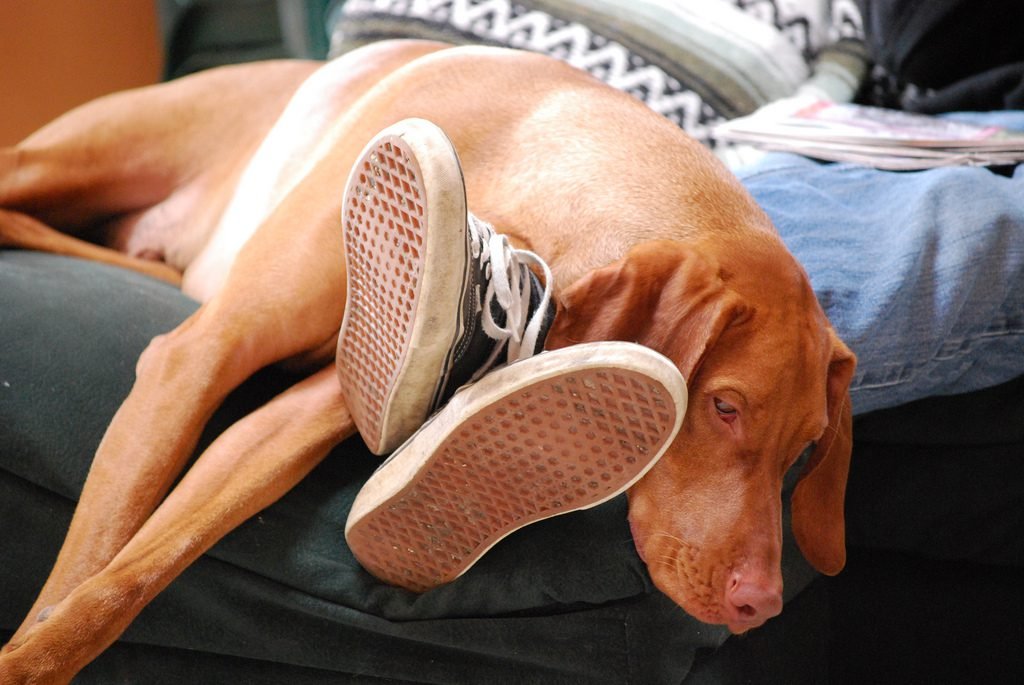Does your dog follow you everywhere? Do they follow you from room to room, even when you go to the bathroom? If so you’re certainly not alone; it seems many of us are the owners of a velcro dog.
What is a Velcro Dog?
A velcro dog is a dog that follows you around and wants to be by your side at all times. Often called clingy, velcro dogs have a desire to be close to their owners. Certain breeds, such as lap dogs, are more likely to be velcro dogs because they’ve been bred to be more dependent. But also breeds that have been bred to work alongside their owners can also be prone to developing attachment issues.
Separation Anxiety vs. Velcro Dog Syndrome
A lot of times velcro dogs and dogs that have separation anxiety are clumped together. Both are associated with not wanting to be away from their owners. But there are subtle differences. Velcro dogs want to be close to their owner, dogs that suffer from separation anxiety panic when they’re away from their owner. Many dogs that exhibit separation anxiety do have a tendency to be velcro dogs as well, but not all velcro dogs have separation anxiety. Separation anxiety is specific to when you leave your dog. A velcro dog exhibits clingy behaviours while you’re home.
Velcro Dog Symptoms:
• Following you from room to room
• Constantly needing or wanting to be next to you
• Keeping an eye on you at all times
• Anticipating when you may be getting up
• Always wanting to be where the action is
Separation Anxiety Symptoms in Dogs:
• Barking or howling when you’re gone
• Destructive chewing (such as doors, window sills, household objects)
• Escape attempts
• Excessive panting or drooling
• Urinating or defecating when you’re gone
• Pacing around
• Your dog becomes anxious when you’re getting ready to leave
• Your dog exhibits inappropriate behaviour only when you’re not there
How to Spot the Difference
Some people consider velcro dogs to have pre-development separation anxiety. There was a study in 2001 that found that dogs who have hyper attachment to their owners are more likely to develop separation anxiety. If your dog is excited when he follows you around it may be a sign that he’s bored and looking for something to do. If your dog stays calm when following you around it’s fine – it’s a common behaviour that many of us find flattering.
But if your dog gets anxious when you get up it’s a sign of separation anxiety. If your dog has a mild case of separation anxiety one thing that can help is giving them something to do when you leave. Like a Kong stuffed with healthy treats when you are leaving the house. After a few days they will understood the drill and start looking forward to the moment you leave because it means ‘I get something yummy.’
So why are some dogs so needy?
Some dogs develop velcro dog syndrome because of our own behaviours. If we stop every time we see our dog to give him praise, a pat on the head, or a treat they learn that staying close leads to the good stuff. Letting your dog sleep in your bed can create a dependence on being close to you. Now this isn’t a bad thing, it’s a personal preference. If you don’t mind it that’s great – it’s just important to understand that many times we encourage our dogs behaviour without realising it.
Boredom and lack of mental stimulation. Dogs can get bored if they’re not given enough mental and physical exercise. Since they’re looking for something to do they’ll leap up and follow you around wherever you go. You’re their main source of their entertainment, so if your dog gets excited when he’s following you around it may be a sign that he’s bored and looking for something to do. If that’s the case find some indoor games you can play to keep your dog busy.
Some breeds have been selectively bred to be dependent. A lot of working, herding, and hound dogs have been bred to work side by side with their humans. They rely on their owners body language and directions for guidance. Many toy breeds were selectively bred to be lap dogs. Some breeds such as German Shepherds and Akitas are commonly known to attach themselves to one person.
Dogs with separation anxiety have a tendency to also be velcro dogs. Some dogs develop a dysfunctional hyper attachment to their owners that causes anxiety when they’re away or out of sight. If your dog is anxious when they’re unable to follow you around they have separation anxiety, not just velcro dog syndrome.
Ageing dogs might stick close to their humans, especially if their hearing or vision starts to change. Those changes can be stressful and scary to the dog, so they’ll stick close to your for extra comfort.
Sudden onset of a clinginess in dogs could also be health related. When your dog becomes sick it can be scary and confusing; they may stick to you as a coping mechanism. If your dog exhibits any sudden behavioural changes it may be a sign of an illness.
Moving into a new house can cause dogs to become extra clingy. Moving can be stressful on dogs, just like it is for us. If your dog seems extra clingy after a move you can help them relax by sticking to a predictable routine to help them settle in.
When Your Dogs Clinginess Becomes a Problem
If you suspect your dog has velcro dog syndrome because he’s bored you’ll probably want to look into giving him some more mental stimulation or a job to do. Dogs that are bored can develop destructive behaviours if left unattended. There’s a lot of simple and quick ways to relieve dog boredom and lots of fun indoor activities to keep your dog busy.
If your dog is only exhibiting velcro dog symptoms it’s up to you to decide if you want to modify the behaviour. The behaviour itself isn’t bad, but there may instances when it’s hazardous for your dog to follow you around, such as when you’re making dinner or cleaning the bathroom.
If your dog has separation anxiety you’ll want to look into getting help to modify the behaviour. Separation anxiety is one of the most common causes of consulting a pet behaviourist. If not treated the behaviour will not go away. It’s similar to anxiety disorders in humans; it can become quite serious if not treated.
If you’d like to reinforce some more independence in your dog there’s some simple training techniques and activities that will help make your dog less clingy.
Desensitize Your Dog to Your Movements
Many dogs react every time we get up because it means ‘uh oh, they’re going somewhere.’ If you practice getting up without going somewhere or doing something important your dog will start to see that it’s really not a big deal or something they need to worry about. They might still watch you, but they won’t feel the need to check on every single thing you do.
Think of all the triggers that get a response from your dog. Do they get up when you put down the remote, or every time you put on your shoes? Work on desensitisation with all of those triggers. Once they’ve seen enough of them time and time again they should start to stop reacting. Eventually they’ll get tired of responding since these triggers will no longer have a strong meaning.
Teach Your Dog the Stay Command
Does your dog have a tendency to follow you into the bathroom and kitchen? If so work on the stay command. When you’re in the kitchen or bathroom teach your dog to stay at a distance. Start with brief distances and gradually move further away. Give your dog a lot of praise when they stay to reinforce that it’s a desired behaviour. Those rewards will let them know that staying is the best choice possible, and they’ll be more likely to repeat that behaviour later on.
Play Games That Rely on Distance
Nose work games, hide and seek, and fetch are all fun games that reinforce having fun while you’re at a distance. Chew toys can be a great choice because they will give your dog something to focus on while on their own. By giving your dog something to do, it shows them that they can have fun and relax, even if you’re not right by their side.
Teach Your Dog to Go to Their Special Place
Using a dog bed or crate gives your dog a special place that’s ‘theirs’. Train them to go to that area by rewarding them when they go there and be sure to add some extra incentive such as toys or treats, something that will make them want to stay there.
Add More Physical Activity to Your Dogs Routine
We’ve all heard that a tired dog is a good dog. If your dog has enough energy to follow you around everywhere chances are they could use some extra exercise. When your dog has enough physical activity they’re much more likely to sleep and relax at home.
Add More Mental Stimulation to Your Dogs Routine
Dogs thrive on meaningful play and activities, so try adding more mental stimulation to their routine. Keeping their brains active makes them tired just as physical activity does. Basic obedience training, agility, nose work, hide and seek, playing tug, and learning new tricks are all ways to mentally tire out your dog.
Our Dogs Thrive When Given a Purpose
Does your dogs clinginess annoy you or do you find it flattering? You’re the one who decides how you’d like your dog to behave. If you don’t mind your dog following you from room to room but don’t want them in the kitchen while you’re cooking set some boundaries. Our dogs look to us for cues; instead of just telling them what not to do offer some acceptable behaviours.
Keeping your dog both mentally and physically challenged will help build your dogs confidence, so they’re happy to go it alone at times.

